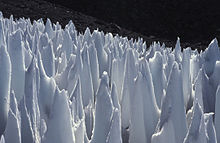Penitente (snow formation)





Penitentes, or nieves penitentes (
The name comes from the resemblance of a field of penitentes to a crowd of kneeling people doing penance. The formation evokes the tall, pointed habits and hoods worn by brothers of religious orders in the Processions of Penance during Spanish Holy Week. In particular, the brothers' hats are tall, narrow, and white, with a pointed top.
These spires of snow and ice grow over all glaciated and snow-covered areas in the Dry Andes above 4,000 metres (13,000 ft).[2][3][4] They range in length from a few centimetres to over 5 metres (16 ft).[4][5]
First description
Penitentes were first described in scientific literature by
Formation
Penitentes are tall, thin blades of hardened snow sculpted by the sun. As the sun hits the snow, it transforms it directly into vapor without melting it, through a process called
Non-terrestrial
Penitentes up to 15 metres (49 ft) high are suggested to be present in the tropics zone on
See also
References
- ^ "Penitentes ESO Australia". Retrieved 10 Jan 2019.
- .
- .
- ^ a b Lliboutry, L. (1965). Traité de Glaciologie, Vol. I & II (in French). Paris, France: Masson.
- ^ Naruse, R.; Lieva, J.C. (1997). "Preliminary study on the shape of snow penitents at Piloto Glacier, the Central Andes". Bulletin of Glacier Research. 15: 99–104.
- ^ Darwin, C. (1839). Journal of researches into the geology and natural history of the various countries visited by H. M. S. Beagle, under the command of Captain Fitz Roy, R.N., 1832 to 1836. London, UK: H. Colburn.
- ^ "The Penitentes, Stunning Snow Formations".
- PMID 11414983.
- ^ Corripio, J.G. (2003). Modelling the energy balance of high altitude glacierised basins in the Central Andes (PDF) (PhD. thesis). Edinburgh, UK: University of Edinburgh. p. 151. Archived (PDF) from the original on 13 November 2013. Retrieved 7 September 2013.
- ^ Corripio, J.G.; Purves, R.S. (2005). "Surface Energy Balance of High Altitude Glaciers in the Central Andes: the Effect of Snow Penitentes" (PDF). In de Jong, C.; Collins, D.; Ranzi, R. (eds.). Climate and Hydrology in Mountain Areas. London, UK: Wiley & Sons. p. 18. Retrieved 7 September 2013.[permanent dead link]
- ^ "Jupiter moon may have huge, jagged ice blades that complicate the search for alien life". NBC News.
- from the original on 2013-12-22. Retrieved 2017-09-28.
- ^ Talbert, Tricia (2017-01-04). "Scientists Offer Sharper Insight into Pluto's Bladed Terrain". NASA. Archived from the original on 2017-01-05. Retrieved 2017-01-05.
- S2CID 4388677.
- ^ "Tartarus Dorsa". Gazeteer of Planetary Nomenclature — International Astronomical Union (IAU) Working Group for Planetary System Nomenclature (WGPSN). 2017-08-08. Retrieved 2023-04-21.
Further reading
- Bergeron, Vance; Berger, Charles; Betterton, M. D. (2006). "Controlled Irradiative Formation of Penitentes". Physical Review Letters. 96 (98502): 098502. S2CID 10549734.
- Kotlyakov, V. M.; Lebedeva, I. M. (1974). "Nieve and ice penitentes, their way of formation and indicative significance". Zeitschrift für Gletscherkunde und Glazialgeologie (in German). X: 111–127. (Describes appearance and formation of these ablation features, with reference to those observed in eastern Pamir, U.S.S.K.)
- Lliboutry, L. (1998). "Glaciers of the Dry Andes". In Williams, R. S. J.; Ferrigno, J. G. (eds.). Satellite Image Atlas of Glaciers of the World. USGS-p1386i. Archived from the original on 2008-06-02. Retrieved 2006-10-25.
{{cite book}}:|work=ignored (help)
External links
 Media related to Ice and snow penitents at Wikimedia Commons
Media related to Ice and snow penitents at Wikimedia Commons- "Spiky glaciers are slower to melt", New Scientist (March 7, 2007).
